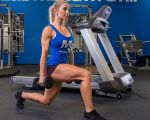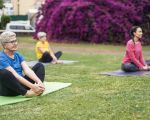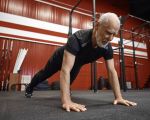- 1. What is Full-Body Circuit Training?
- 2. The Benefits of Full-Body Circuit Training
- 3. Best Circuit Training Exercises for Full-Body Fitness
- 4. How to Create Your Own Full-Body Circuit Training Routine
- 5. Tips for Maximizing Your Full-Body Circuit Workout
- 6. Real-Life Example: A Successful Full-Body Circuit Training Journey
1. What is Full-Body Circuit Training?
Full-body circuit training is a highly effective workout routine that combines strength training and cardio exercises into one session. The workout is structured into "circuits," where a series of exercises are performed consecutively with minimal rest in between. Typically, a circuit consists of exercises that target different muscle groups, ensuring that the entire body is engaged throughout the workout.
This type of training is ideal for those who want to improve their overall fitness, increase muscle tone, and burn fat. It’s perfect for individuals with limited time, as circuit training offers a comprehensive workout that maximizes results in a short amount of time. Full-body circuit training can be done with or without equipment, making it suitable for both the gym and home workouts.
2. The Benefits of Full-Body Circuit Training
Full-body circuit training offers numerous advantages that make it an appealing choice for people of all fitness levels. Below are some key benefits:
- Time-Efficient: One of the biggest benefits of circuit training is that it can provide a full-body workout in a short amount of time. By alternating between exercises and minimizing rest periods, you can complete a circuit in 20-30 minutes while still getting an intense workout.
- Improved Cardiovascular Fitness: Circuit training boosts heart rate, improving cardiovascular health while still working muscles for strength. This combination of strength training and cardio makes it more effective than traditional workouts focused on just one or the other.
- Increased Calorie Burn: Because of its intensity, circuit training keeps the body in a fat-burning mode for a longer period after the workout. This "afterburn" effect means you’ll continue to burn calories even after your workout has ended.
- Versatile and Adaptable: Circuit training is highly adaptable to individual fitness levels. Whether you’re a beginner or an advanced athlete, you can adjust the difficulty of the exercises and rest intervals to suit your needs.
These benefits make full-body circuit training an excellent choice for those looking to improve their overall fitness in a fun and efficient way.
3. Best Circuit Training Exercises for Full-Body Fitness
When it comes to full-body circuit training, a well-rounded set of exercises should target different muscle groups, including the core, upper body, and lower body. Here are some of the best exercises to include in your circuit:
- Push-ups: Push-ups are a classic upper-body exercise that targets the chest, shoulders, and triceps. They’re simple yet effective for building strength and endurance.
- Squats: Squats are a great lower-body exercise that targets the quadriceps, hamstrings, and glutes. They also engage the core, making them a full-body movement.
- Burpees: Burpees are a combination of a squat, push-up, and jump, making them a high-intensity exercise that works almost every muscle in your body while also providing an excellent cardio boost.
- Planks: Planks are an isometric exercise that targets the core, shoulders, and back. They help improve overall stability and posture.
- Lunges: Lunges are a great lower-body movement that targets the quads, glutes, and hamstrings. They also engage the core and improve balance and coordination.
- Dumbbell Rows: Dumbbell rows target the upper back, shoulders, and arms. They’re great for building strength and improving posture.
Incorporating these exercises into your circuit ensures that you’re working all major muscle groups, enhancing strength, endurance, and overall fitness.
4. How to Create Your Own Full-Body Circuit Training Routine
Creating a full-body circuit training routine involves selecting exercises that target different muscle groups and alternating between them with minimal rest. Here’s how to structure your routine:
- Choose Your Exercises: Select 6-8 exercises that target different muscle groups (e.g., upper body, lower body, and core). Include both strength and cardio exercises to get the full benefit of circuit training.
- Set Your Reps and Time: Decide on the number of reps (for strength exercises) or time (for cardio exercises) you’ll do for each movement. A typical circuit lasts around 30-60 seconds per exercise, with 10-15 reps for strength exercises.
- Rest Periods: Keep rest periods between exercises minimal, around 15-30 seconds, to maintain the intensity of the workout. You can rest for 1-2 minutes after completing one full round of the circuit.
- Repeat the Circuit: Perform the circuit 2-4 times, depending on your fitness level. Beginners may start with 2 rounds, while more advanced athletes can complete 4 or more rounds for maximum intensity.
Creating a balanced circuit workout that alternates between different muscle groups ensures that you’re challenging your body in multiple ways while keeping the workout engaging and effective.
5. Tips for Maximizing Your Full-Body Circuit Workout
To make the most out of your full-body circuit training routine, keep the following tips in mind:
- Focus on Form: Proper form is key to preventing injury and maximizing the benefits of each exercise. Take your time and perform each movement with control.
- Stay Hydrated: Full-body circuits can be intense, so be sure to drink water before, during, and after your workout to stay hydrated and maintain your energy levels.
- Mix it Up: Change up your exercises or the order of your routine every few weeks to keep things fresh and challenge your body in new ways.
- Listen to Your Body: If you’re feeling fatigued or experiencing pain, it’s important to take a break or modify the exercises. Always listen to your body to avoid overtraining.
By following these tips, you can ensure that you’re getting the most out of your circuit training sessions and staying on track with your fitness goals.
6. Real-Life Example: A Successful Full-Body Circuit Training Journey
Take the example of Sarah, who wanted to lose weight and build strength but didn’t have a lot of time to spend at the gym. She started incorporating full-body circuit training into her routine, performing three circuits a week at home with minimal equipment. Over the course of a few months, Sarah saw significant improvements in her fitness level. She lost weight, gained muscle tone, and felt more energized throughout the day.
Sarah’s success story highlights how full-body circuit training can be an incredibly effective and time-efficient workout method. Whether you’re a busy professional or someone just looking to improve overall fitness, full-body circuit training offers a well-rounded solution to meet your goals.








